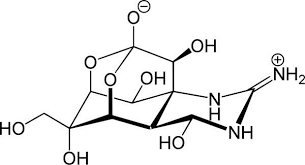
DEFINITION
The name “Fugu Poisoning” refers to Fugu or “Takifugu” a Japanese traditional delicacy which is prepared from Tetrodotoxin producing beings such as Pufferfishes, usually served as a soup or as “Sashimi Fugu” (raw Pufferifish meat).
Epidemiology:
Anyone who consumes this kind of edibles is susceptible of disease.
Although this kind of poisoning occurs mostly in the Indo-Pacific areas and are rare in western countries such as Europe and United States, Tetradotoxin producing fishes have been found in the Mexico Gulf and Atlantic Ocean.
The first recorded cases of TTX poisoning were from the logs of Captain James Cook from 7 September 1774, on which date Cook recorded his crew eating some local tropic fish, then feeding the remains to the pigs kept on board. The crew experienced numbness and shortness of breath, while the pigs were all found dead the next morning.
Reports of intoxication have been 646 between 1974 and 1983. Mean rate of incidence is 20-40 cases per year while mortality rate is highly variable from place to place. Tokyo’s mortality rate is about 7% but rates up to 50% have been reported.
Higher mortality rates usually come from less industrialized eastern countries such as Malaysia, Philippines, Thailand.
The highest number of fatalities occurs in domestic preparation rather than in restaurants: this is likely to result from improper methods as well as confusion between types of Puffers.
A small number of TTX intoxication are intentional suicidal attempts.

Symptoms:
Symptoms of the intoxication are related to the toxin activity and include (in order of appearance):
- numbness of lips and tongue
- dizziness
- tingling
- increasing paraesthesias
- gastrointestinal symptoms such as nausea, vomiting and diarrhea (often severe)
- impaired heart rate
- paralysis: impaired speech, increasing dyspnea, hypotension, respiratory failure
- seizures, coma and exitus
Symptoms are strictly dose-dependent and the fastness of onset may vary. Death may occur in few minutes or up to 8 hours. People who survive the first 24 hours are likely to survive.
Diagnosis:
Diagnosis is based mainly on the anamnesis: if possible, the toxin should be demonstrated on a sample of the consumpted food.
Tetrodotoxin may be quantified in serum, whole blood or urine to confirm a diagnosis of poisoning in hospitalized patients or to assist in the forensic investigation of a case of fatal overdose. Most analytical techniques involve mass spectrometric detection following gas or liquid chromatographic separation.
Pathogenesis:
Tetrodotoxin (sometimes referred to as “Tetradotoxin”, abbreviated TTX) is a powerfull poison acting as a neurotoxin.
It is contained in the liver, gonads, skin and intestines of a large variety of marine species such as Pufferfishes (Tetraodontidae Family), Blue Ringed Octopus, Xantid Crabs, Atelopus Toads etc. It can enter the body by ingenstion, inhalation, skin abrasion and causes paralysis of voluntary muscles as well as the loss of regulation of the heart rate.
Serving of the Pufferfish’ liver ("Kimo"), that is considered the most tasty yet toxic part, is prohibed in Japan.

Studies conducted on such species have shown that the responsibles of the production of toxin are not the fishes, but symbiotic bacteria such as some Psudomonas spp, Pseudoalteromonas Tetraodonis and Vibrio Algynoliticus.
Pufferfishes grown in tanks have been reported not to produce TTX since free from the bacteria named above. Recently, Raoultella Terrigena have been reported to produce TTX (Isolation and identification of a new Tetrodotoxin-producing bacterial species, Raoultella Terrigena, from Hong Kong marine pufferisfish Takifugu niphobles).
Molecular Activity
The toxin, whose formula is C11H17N3O8, have been shown to bind to the outer pore of several subclasses of voltage dependent sodium ion channels. Nav1.4, encoded by the gene SCN4A, is primarily expressed in skeletal muscles and its interaction with TTX explains most of the symptomps.
Tetrodotoxin is a thermoresistant molecule: heating does not affect its properties.
Its structure has been described in 1964 by both Japanese and American equipes.
It has a Guanidic positively charged group bound to five hydroxylated rings. It is not yet clear which compounds take part int the synthesis of the TTX, but Arginine seems to be the basic aminoacid upon which other molecules are added. Its extremely polar features strenghten the bond with its molecular target.
The binding site is referred to as “Site 1”: Saxitoxin and Conotoxins interact with Site 1 aswell.
Two different classes of Na+ voltage gated channels have been discovered: TTXr channels (Tetradotoxin resistant) and TTXs channels (Tetradotoxin sensitive). While TTXr channels are mostly located on Myocardial Nerves, TTXs channels have been found mostly on Central Nervous System. The sensitivity to TTX seems to be determined by a single residue, Tyrosine 401 on Nav1.4: substitution of this aminoacyd with Serine or Cysteine conferred resistence to TTX (Pharmacological properties of neuronal TTX-resistant sodium channels and the role of a critical serine pore residue).
Interaction with Site 1 blocks the fast sodium currents in Myocites: this inhibits calcium release from sarcoplasmatic reticule therefore causing paralysis of the respiratory muscles (mostly the Diagraphagm).
At the same time the Myocites surrounding the Sino-Atrial node result inhibited: consequently the heart-rate results impaired.
The LD50 for the TTX is very different depending on the way of assumption. Medium lethal dosage for mice ingesting TTX have been shown to be 334 micrograms/kilos. This means that 25mg could be enough to cause the death of an average man (75kgs).

Therapy:
Cardio-respiratory support is the most important step in managing this kind of intoxication.
Gastric lavage and administration of activated charcoal reduce the absorption of the venom.
Administration of alfa-adrenoreceptor agonists and hydration is strongly recommended in order to prevent hypotension.
Administration of anti-colesterasis drugs have been reported to have no evidence of improving.
No antidote is known up to date, but monoclonal antibodies against TTX gave positive results in murine test
Curiosity
Created by Tommaso Benincasa and Chiara Cavallin